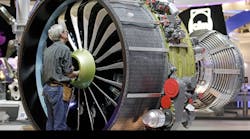Allegheny Technologies Inc. has an agreement to supply titanium investment castings to Snecma for single-aisle and business jet engine programs, including the CFM LEAP family. The agreement begins in 2015 and continues past 2020, though more specific details (including its estimated revenue potential) were not made available.
Snecma, a unit of the Safran Group, designs and manufactures engines for civilian and military aircraft, as well as launch vehicles and satellites, including the CFM56 and LEAP engines for commercial aircraft programs.
The CFM56 is a high-bypass turbofan engine offered in several variants, all common in design by different in their power ratings. The LEAP engine, also a high-bypass turbofan design, was developed by the CFM International joint venture and manufactured independently by the venture’s two partners, Snecma and GE Aviation. It is considered a replacement for the partners’ basic turbofan engines, Snecma’s CFM56 and GE Aviation’s GEnx.
The CFM LEAP engines are designed for single-aisle aircraft, including the new Airbus A320neo and Boeing 737 MAX, and the Comac C919, the new single-aisle aircraft being developed by the Commercial Aircraft Corp. of China.
“We are pleased with this agreement with Snecma,” stated Rich Harshman, ATI chairman, president and CEO. “The new agreement builds on our long-term strategic relationship with Snecma (Safran) and recognizes our integrated capabilities from raw materials (titanium sponge) through mill products to forgings, investment castings, and components.”
ATI’s titanium investment casting capabilities are centered at the Portland, OR, operation formerly known as Pacific Cast Technologies. ATI paid $883 million for Ladish Inc. in 2011, acquiring several forging operations as well as the investment caster.
“Through this agreement, ATI is positioned to significantly grow our titanium investment casting content on jet engines powering next-generation single aisle aircraft. This agreement represents one of several growth opportunities for ATI’s integrated titanium investment casting business, and supports our goal to at least double the revenue of this business within the next five years.”









